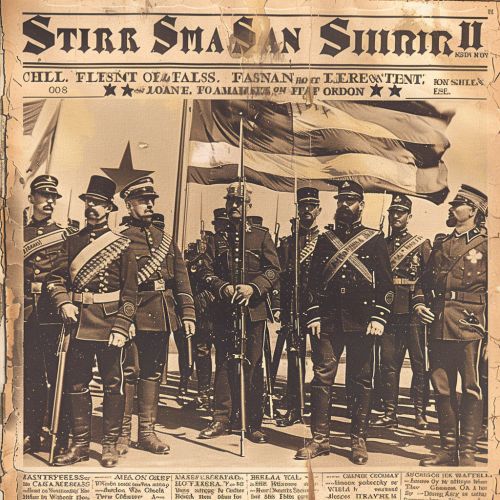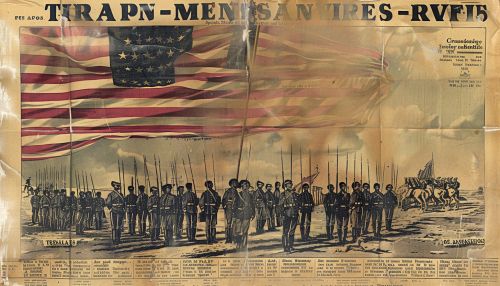Stars and Stripes (newspaper)
History


The "Stars and Stripes" newspaper has a storied history that dates back to the American Civil War. It was first published on November 9, 1861, by Union soldiers during the Siege of Bloomfield, Missouri. The initial purpose of the publication was to boost the morale of the troops and provide them with news from the front lines as well as from home. The publication was short-lived during the Civil War, ceasing operations after the war ended.
The newspaper was revived during World War I by the American Expeditionary Forces (AEF) in France. The first issue of the revived "Stars and Stripes" was published on February 8, 1918. The publication was managed by a team of enlisted men and officers, including Harold Ross, who later founded "The New Yorker" magazine. The newspaper provided soldiers with news from the home front, updates on the war, and features on various topics of interest to the troops.
During World War II, "Stars and Stripes" expanded significantly, publishing multiple editions in different theaters of operation, including Europe, the Mediterranean, and the Pacific. The newspaper played a crucial role in keeping soldiers informed and connected to home, providing a mix of news, entertainment, and information on military operations.
Structure and Operations
"Stars and Stripes" operates as an independent editorially entity within the Department of Defense (DoD). It is unique among military publications in that it maintains editorial independence, meaning that its content is not subject to censorship by military authorities. This independence is crucial for maintaining the credibility and trust of its readership.
The newspaper is funded through a combination of appropriations from the DoD and revenue from sales, subscriptions, and advertising. It is distributed to military personnel stationed around the world, including those in combat zones, as well as to their families and civilian employees of the DoD.
The editorial staff of "Stars and Stripes" includes both civilian journalists and military personnel. The newspaper covers a wide range of topics, including news, sports, entertainment, and opinion pieces. It also provides in-depth coverage of military issues, including policy changes, deployments, and veterans' affairs.
Digital Transition
In recent years, "Stars and Stripes" has undergone a significant digital transformation. The newspaper maintains a robust online presence, with a website that features daily news updates, multimedia content, and interactive features. The digital edition allows for real-time updates and a broader reach, ensuring that military personnel and their families can access the latest news and information regardless of their location.
The transition to digital has also allowed "Stars and Stripes" to engage with its audience in new ways, including through social media platforms and mobile applications. This digital presence complements the traditional print editions, which continue to be published and distributed worldwide.
Editorial Independence and Challenges
One of the defining characteristics of "Stars and Stripes" is its editorial independence. This independence is enshrined in its charter, which ensures that the newspaper can operate free from undue influence or censorship by military authorities. This independence is vital for maintaining the trust and credibility of its readership, who rely on the newspaper for accurate and unbiased information.
However, maintaining this independence has not been without challenges. Over the years, there have been instances where military and political leaders have attempted to influence the content of "Stars and Stripes." The newspaper's staff has consistently resisted these pressures, upholding the principles of journalistic integrity and independence.
In 2020, "Stars and Stripes" faced a significant challenge when the DoD announced plans to cut funding for the newspaper. This decision was met with widespread opposition from military personnel, veterans, and lawmakers, who argued that the newspaper provides an essential service to the military community. Ultimately, the funding was restored, and "Stars and Stripes" continues to operate as an independent news organization.
Notable Contributions and Impact
"Stars and Stripes" has made significant contributions to journalism and has had a lasting impact on the military community. Over the years, the newspaper has covered major conflicts, including the Korean War, the Vietnam War, the Gulf War, and the wars in Iraq and Afghanistan. Its reporting has provided valuable insights into the experiences of military personnel and the realities of war.
The newspaper has also been a training ground for many notable journalists. Alumni of "Stars and Stripes" include Pulitzer Prize-winning journalists and prominent media figures. The experience of reporting for "Stars and Stripes" has helped shape the careers of many journalists, providing them with unique perspectives and skills.
In addition to its news coverage, "Stars and Stripes" has played a role in fostering a sense of community among military personnel. The newspaper has featured stories on military families, veterans' issues, and the achievements of service members. It has also provided a platform for the voices of military personnel, publishing letters to the editor and opinion pieces.
See Also
- American Civil War
- World War I
- World War II
- Department of Defense
- Journalistic Integrity
- Digital Transformation
